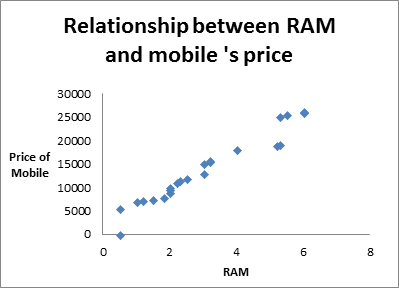
Concept explainers
In addition to the key words, you should also be able to define each of the following terms:
| Positive relationship | ratio scale |
| Negative relationship | self-report measure |
| Accuracy | physiological measure |
| Scale of measurement | behavioral measure |
| Nominal scale | |
| Ordinal scale | artifact |
| Interval scale | subject roles or subject role behaviors |
The definition of the following terms.
Explanation of Solution
Positive Relationship:
In statistics, a positive relationship or positive correlation is defined as the relationship between two variables in which, increment (decrement) in one variable results in increment(decrement) of another variable (not necessarily in same ratio). In other words, positive relationship is the relationship between the two variables in which both variable moves in same direction.
For example, increment in RAM results in increment in price of mobile. The positive relationship can also be seen graphically through scatter plot.

Negative Relationship:
In statistical terms, a negative relationship or negative correlation is defined as the relationship between two variables in which both the variables move in opposite direction, that is, increment(decrement) in the value of one variable results in decrement (increment) of other.
For example, on increasing the temperature of microwave, the time taken by water to boil is decreased.

Accuracy:
Statistics is not about deterministic value, it's about estimated value which is close to accurate value. While doing an experiment, one can never get exact value. So accuracy tells the closeness between true value and estimated value.
For example, a sample is drawn from a population having mean 30 and the sample mean is 29 then one can say that sample mean is accurate to within 1 unit.
Scale of Measurement:
The term 'measurement' is used in our daily lives very broadly but in statistics, the term 'scale of measurement' is used which is more appropriate and is used to categorize the variables. The scale of measurement gives some ways to categorize the variables. The scale of measurement is divided into four scales- nominal, ordinal, interval and ratio scale. Each scale has its own properties on the basis of which the variables can be categorized. This categorization is very useful while performing statistical analysis and without this categorization, it is not possible to perform analysis. The scale of measurement works as base of statistical analysis.
Nominal Scale:
The scale which consists of variables having categories and do not have any order is known as nominal scales and the variables are known as nominal or categorical variables. These variables are simply used as identifiers such as blood group (AB, A, B, O), gender (male and female), residential area (urban and rural) etc.
In this, categories of any variables can be assigned the codes in the form of the numbers and those numbers work as the labels. For a variable gender, male can be assigned as 0 and females as 1.
Ordinal Scale:
The ordinal scale contains the variables having categories and should be placed in order and the variables are known as ordinal variables. For example, ranks achieved in drawing competition, that is, first, second and third positions.
This scale is not used to represent the quantity.
Interval Scale:
The term 'interval' means 'gap in between' which shows the importance about each value between items. An interval scale is a scale in which zero point is arbitrary. In this scale, scores can be added and subtracted but cannot be multiplied meaningfully. For example, temperature because there is no such thing as 'no temperature'.
Ratio Scale:
The scale, consisting of the variable having true zero point is known as the ratio scale. In ratio scale, the percentage is useful unit. For example, weight is expressed in kilograms and also in grams and they are linearly related as 1kg=1000gms. Here 0 kilograms and 0 gram is same and would have no weight.
Self-Report Measure:
In self-report measure, we do a study based on questionnaire or survey. Here, respondents select their responses themselves and questions are based on their feelings, attitudes, behaviour etc. and record their answers.
Self report measures are operational definitions in which respondents are asked to fill the questionnaire about their own behaviour or mental conditions.
Psychological Measurement:
Psychological measurement deals with the measurement of psychological traits or mental abilities like intelligence, aptitude, interest, opinion, honesty or attitude. Psychological characteristics can be measured only with some degree of unreliability. The psychological scale is an interval scale because there is no absolute zero-point on the scale.
Behavioural Measure:
Behavioural measures are tests and methods, targets on information from a subject of interest. It contain over actions and reactions of respondents.
Range Effect:
When each subject of interest receives more than one experimental condition then range effect occurs. The range effects are critical to measurement of almost any kind of human behaviour.
Artefact:
In econometrics, artefact is defined as an error which occurs during data manipulation or in the case of selection of faulty choice of variables.
Subject role or subject role behaviours:
It includes the study of human thoughts and actions, individually as well as collectively. In this, the behaviour and reactions of human are recorded for any particular situation.
Want to see more full solutions like this?
Chapter 3 Solutions
Research Methods for the Behavioral Sciences (MindTap Course List)
- A marketing agency wants to determine whether different advertising platforms generate significantly different levels of customer engagement. The agency measures the average number of daily clicks on ads for three platforms: Social Media, Search Engines, and Email Campaigns. The agency collects data on daily clicks for each platform over a 10-day period and wants to test whether there is a statistically significant difference in the mean number of daily clicks among these platforms. Conduct ANOVA test. You can provide your answer by inserting a text box and the answer must include: also please provide a step by on getting the answers in excel Null hypothesis, Alternative hypothesis, Show answer (output table/summary table), and Conclusion based on the P value.arrow_forwardA company found that the daily sales revenue of its flagship product follows a normal distribution with a mean of $4500 and a standard deviation of $450. The company defines a "high-sales day" that is, any day with sales exceeding $4800. please provide a step by step on how to get the answers Q: What percentage of days can the company expect to have "high-sales days" or sales greater than $4800? Q: What is the sales revenue threshold for the bottom 10% of days? (please note that 10% refers to the probability/area under bell curve towards the lower tail of bell curve) Provide answers in the yellow cellsarrow_forwardBusiness Discussarrow_forward
- The following data represent total ventilation measured in liters of air per minute per square meter of body area for two independent (and randomly chosen) samples. Analyze these data using the appropriate non-parametric hypothesis testarrow_forwardeach column represents before & after measurements on the same individual. Analyze with the appropriate non-parametric hypothesis test for a paired design.arrow_forwardShould you be confident in applying your regression equation to estimate the heart rate of a python at 35°C? Why or why not?arrow_forward
 Glencoe Algebra 1, Student Edition, 9780079039897...AlgebraISBN:9780079039897Author:CarterPublisher:McGraw Hill
Glencoe Algebra 1, Student Edition, 9780079039897...AlgebraISBN:9780079039897Author:CarterPublisher:McGraw Hill Holt Mcdougal Larson Pre-algebra: Student Edition...AlgebraISBN:9780547587776Author:HOLT MCDOUGALPublisher:HOLT MCDOUGAL
Holt Mcdougal Larson Pre-algebra: Student Edition...AlgebraISBN:9780547587776Author:HOLT MCDOUGALPublisher:HOLT MCDOUGAL Big Ideas Math A Bridge To Success Algebra 1: Stu...AlgebraISBN:9781680331141Author:HOUGHTON MIFFLIN HARCOURTPublisher:Houghton Mifflin Harcourt
Big Ideas Math A Bridge To Success Algebra 1: Stu...AlgebraISBN:9781680331141Author:HOUGHTON MIFFLIN HARCOURTPublisher:Houghton Mifflin Harcourt Linear Algebra: A Modern IntroductionAlgebraISBN:9781285463247Author:David PoolePublisher:Cengage Learning
Linear Algebra: A Modern IntroductionAlgebraISBN:9781285463247Author:David PoolePublisher:Cengage Learning Functions and Change: A Modeling Approach to Coll...AlgebraISBN:9781337111348Author:Bruce Crauder, Benny Evans, Alan NoellPublisher:Cengage Learning
Functions and Change: A Modeling Approach to Coll...AlgebraISBN:9781337111348Author:Bruce Crauder, Benny Evans, Alan NoellPublisher:Cengage Learning




